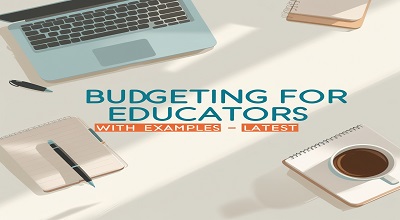Budgeting for Educators
Budgeting for Educators: Budgeting is a crucial skill for educators, who often face financial challenges due to modest salaries and classroom expenses. Effective budgeting helps teachers manage personal finances, reduce stress, and achieve long-term financial goals.
In this comprehensive guide, we’ll explore practical budgeting strategies, tools, and real-life examples tailored for educators. Whether you’re a new teacher or a seasoned educator, this post will help you take control of your finances.
Why Budgeting is Essential for Educators?
Educators often spend their own money on classroom supplies, professional development, and student needs. Without a proper budget, it’s easy to overspend and struggle with savings.
Key Benefits of Budgeting for Teachers:
- Financial Stability: Avoid living paycheck to paycheck.
- Debt Reduction: Manage student loans and credit card debt.
- Savings Growth: Build an emergency fund and retirement savings.
- Classroom Management: Allocate funds wisely for school supplies.
Types of Budgets for Educators
Different budgeting methods suit different financial situations. Here are the most effective ones:
A. Zero-Based Budgeting
- Every dollar is assigned a purpose (expenses, savings, or debt).
- Example: If you earn $3,500/month, allocate all $3,500 to bills, savings, and extras.
B. 50/30/20 Budget Rule
- 50% Needs (rent, groceries, utilities)
- 30% Wants (dining out, hobbies)
- 20% Savings/Debt (emergency fund, retirement, loans)
C. Envelope System
- Cash is divided into envelopes for different spending categories.
- Helps control overspending.
D. Classroom-Specific Budgets
- Separate budget for school-related expenses (books, supplies, field trips).
Step-by-Step Guide to Creating a Budget
1: Calculate Your Monthly Income
- Include salary, side gigs, and passive income.
2: List Fixed and Variable Expenses
- Fixed: Rent, car payments, insurance.
- Variable: Groceries, entertainment, classroom supplies.
3: Set Financial Goals
- Short-term (emergency fund)
- Long-term (retirement, home purchase)
4: Track Spending
- Use apps like Mint or YNAB (You Need A Budget).
5: Adjust and Review Monthly
- Cut unnecessary expenses.
- Increase savings if possible.
Budgeting Tools and Apps for Educators
| Tool | Features |
|---|---|
| Mint | Free budgeting, expense tracking |
| YNAB | Zero-based budgeting, debt tracking |
| EveryDollar | Dave Ramsey’s budgeting method |
| Google Sheets | Customizable budget templates |
Common Budgeting Mistakes and How to Avoid Them
- Not Tracking Small Purchases → Use cashback apps like Rakuten.
- Ignoring Emergency Funds → Save at least 3-6 months’ expenses.
- Overestimating Income → Base budget on net (not gross) pay.
Real-Life Budgeting Examples for Educators
Example 1: New Teacher (Single, $45,000/year)
- Income: $3,000/month after taxes
- Expenses:
- Rent: $1,000
- Groceries: $300
- Student Loans: $400
- Classroom Supplies: $100
- Savings: $200
Example 2: Veteran Teacher (Married, $70,000/year)
- Income: $4,500/month (combined)
- Expenses:
- Mortgage: $1,500
- Childcare: $800
- Retirement Savings: $600
- Professional Development: $200
Tips for Sticking to Your Budget
✅ Automate Savings – Set up direct deposits to savings accounts.
✅ Use Cash for Discretionary Spending – Limits overspending.
✅ Review Weekly – Adjust before small issues become big problems.
Conclusion
Budgeting empowers educators to manage finances confidently. By following structured plans, tracking expenses, and using smart tools, teachers can reduce financial stress and secure their future.
Start today—your future self will thank you!
Frequently Asked Questions (FAQs)
Q1: How much should educators save monthly?
Aim for 20% of income, prioritizing emergency funds first.
Q2: What’s the best app for teacher budgeting?
YNAB (You Need A Budget) is highly recommended for zero-based budgeting.
Q3: How can teachers reduce classroom expenses?
- Use DonorsChoose for funding.
- Buy supplies in bulk during back-to-school sales.
